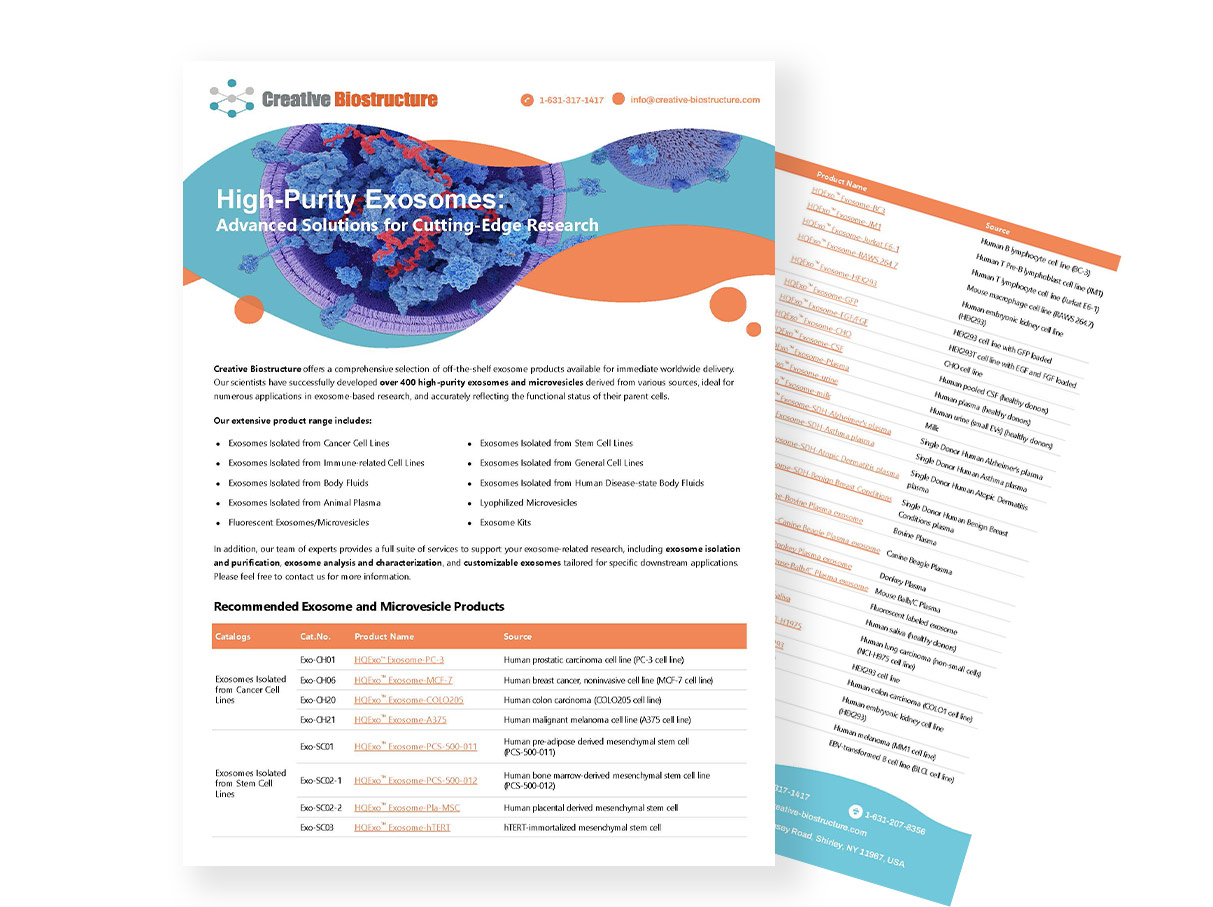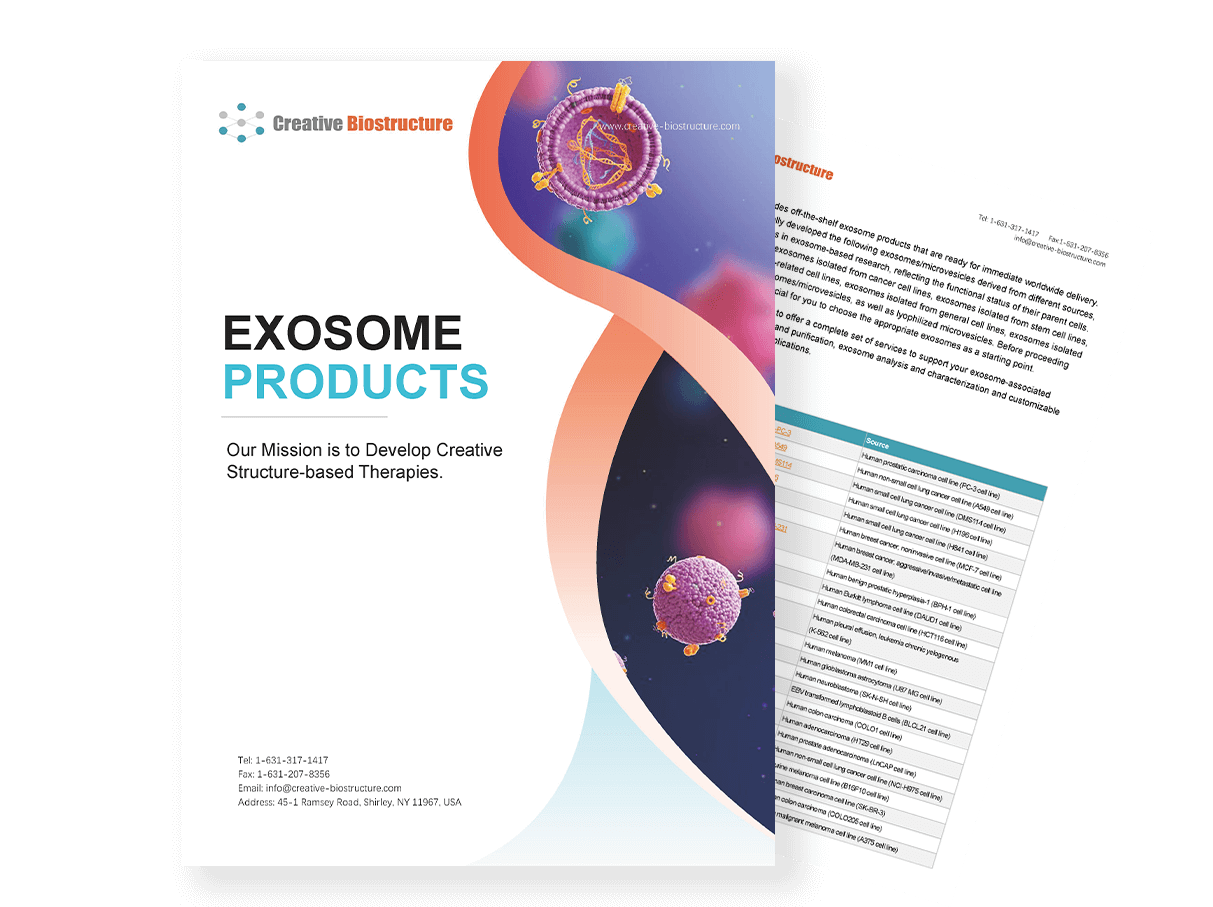Exosomes Isolated from Human Disease-state Body Fluids
The composition of exosomes changes in disease states, reflecting the cellular and molecular alterations associated with the disease process (cancer cells, neurodegenerative diseases, heart disease, infections). These disease-associated exosomes carry biomolecules proteins, lipids, RNA, DNA—often derived from the same cell as the disease host, a "microscopic" view of the disease world. Exosomes are invaluable in research and diagnostics due to their ability to carry disease-specific biomarkers. They can be isolated and analyzed to understand how diseases occur, when the diseases progress, and how treatment works.
At Creative Biostructure, we offer high-quality HQExo™ standard exosomes that serve as reliable positive controls for functional research applications, including enzyme-linked immunosorbent assay (ELISA), flow cytometry (FACS), and Western blotting (WB). Our HQExo™ exosome products ensure high purity and quality, supporting diverse research needs and promoting reliable exosome-based studies.
Product List
Background
Exosome release and content are influenced by factors such as the individual's health status and the presence of disease. The cargo of exosomes changes in disease conditions, serving as markers for cancer, neurodegenerative diseases, heart disease, and infections. The molecular fingerprint and stability of exosomes make them the perfect targets for non-invasive biomarker discovery, providing an accessible way to understand cellular processes and pathological changes in the body.
The isolation of exosomes from body fluids is challenging due to the presence of other extracellular particles and requires techniques such as ultracentrifugation, size-exclusion chromatography, immunoaffinity capture, and polymer precipitation. Ultracentrifugation and precipitation are commonly used to isolate exosomes, which contain apoproteins suitable for downstream analyses. Nanoparticle tracking analysis (NTA) is used to measure exosome particle concentration, while WB and ELISA are used to analyze exosomal biomarkers.
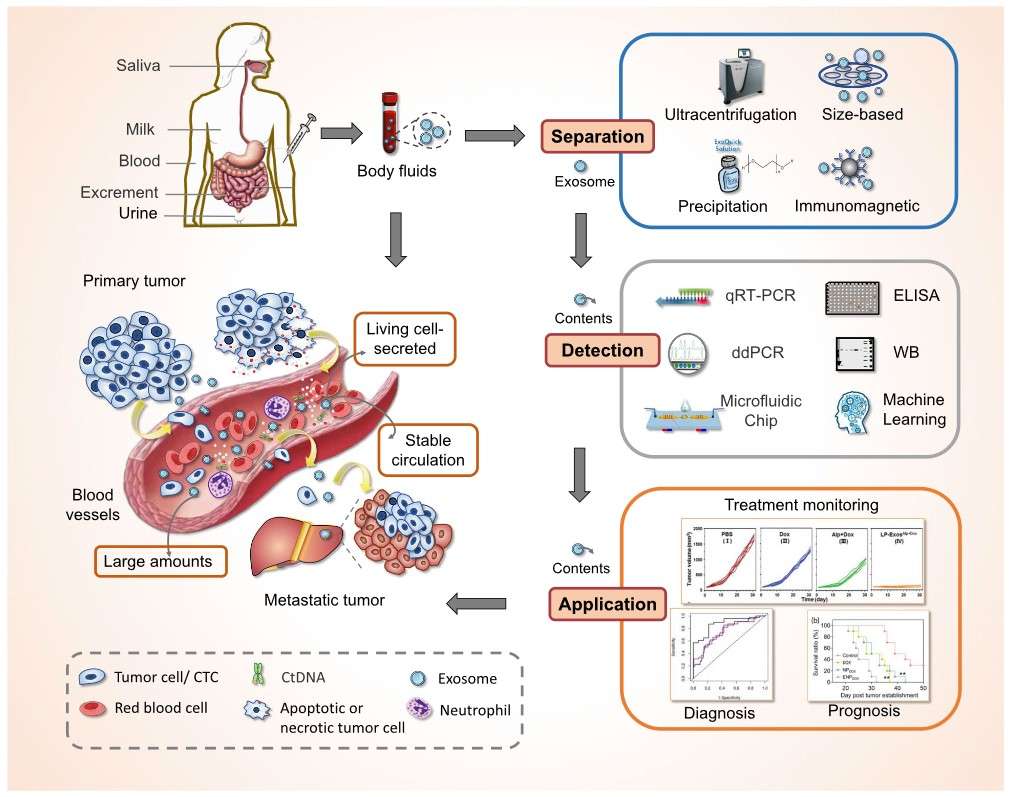 Figure 1. Exosomes as a new target for liquid biopsy. Exosomes are enriched in body fluids and are critically involved in tumorigenesis, tumor progression and metastasis. Compared with circulating tumor cells (CTC) and circulating tumor DNA (ctDNA), exosomes show superior characteristics such as living-cell secreted vesicles, large amounts and stable circulation. Traditional and advanced technologies have been used to separate exosomes from various body fluids and to detect exosomal cargoes. The detection of specific exosomal molecules may provide a new strategy for cancer diagnosis, progression monitoring, and prognosis prediction. (Yu D, et al., 2022)
Figure 1. Exosomes as a new target for liquid biopsy. Exosomes are enriched in body fluids and are critically involved in tumorigenesis, tumor progression and metastasis. Compared with circulating tumor cells (CTC) and circulating tumor DNA (ctDNA), exosomes show superior characteristics such as living-cell secreted vesicles, large amounts and stable circulation. Traditional and advanced technologies have been used to separate exosomes from various body fluids and to detect exosomal cargoes. The detection of specific exosomal molecules may provide a new strategy for cancer diagnosis, progression monitoring, and prognosis prediction. (Yu D, et al., 2022)
Applications of Exosomes Isolated from Disease-state Body Fluids
Biomarker Discovery and Validation
Exosomes isolated from a diseased fluid have become known as biomarkers of disease. Because exosomes are rich in molecular characteristics from the cells of their origin, they are useful in diagnosing cancer, Alzheimer's disease, and cardiovascular diseases. In oncology, the tumor-derived exosomes in blood or body fluids express the correct oncogenes, mutated DNA, or cancer-related proteins, revealing the type of cancer, stage of cancer, and even metastasis of cancer. Because exosomes contain proteins and RNA molecules associated with neurodegeneration, the biological fluids, like cerebrospinal fluid, will contain them in abundance—a method of detection and monitoring progression invaginated in neurodegenerative diseases.
Drug Response Studies
Disease-state exosomes can be mapped with disease state exosomes to see how different diseases interact with drugs at the cellular level. Exosomes from treated and untreated disease samples allow exosomal chemistry to be measured for changes in exosomal content, which can be used for drug mechanism analysis and therapeutic effect studies.
Gene and RNA Research
Exosomes are rich in non-coding RNAs such as microRNAs, mRNAs, etc. Disease state exosomes can be used to track gene expression and RNA regulation in disease states, providing insights into how genes and epigenetics drive disease states.
Inflammation and Immune Response Analysis
Exosomes from diseased states have been found to carry immunoglobulins and molecules typical for inflammatory or immunomodulatory processes. Researchers use these exosomes to study immune responses in diseases with the view to elucidating the role of inflammation and immune signaling in disease pathogenesis.
Case Studies
Case Study 1: Micro-RNAs in Brain-Derived Extracellular Vesicles: Potential Biomarkers for Alzheimer's Diagnosis and Monitoring
There are evidences that demonstrate brain cells release extracellular vesicles (EVs) into the blood, so the Cha group perhaps EVs in the brain in the blood can detect brain disease states like Alzheimer's disease (AD). Since microRNAs (miRNAs) are dysregulated in brain tissue in AD studies, miRNAs in neural EVs of AD blood have also been examined. High-content miRNA arrays revealed 12 miRNAs altered in AD brain tissue—six that were also altered from highly pathologic controls (HPCs). Analyses of brain tissue and neurally derived blood EVs from AD patients, mild cognitively impaired (MCI) patients and controls identified four miRNAs that were significantly different in groups. In particular, miR-132-3p in blood EVs were very sensitive and specific to AD diagnosis, and miR-212 was reduced in AD cases. All of this points to miR-132 and miR-212 expression in neural EVs as potential markers or treatments for Alzheimer's disease.
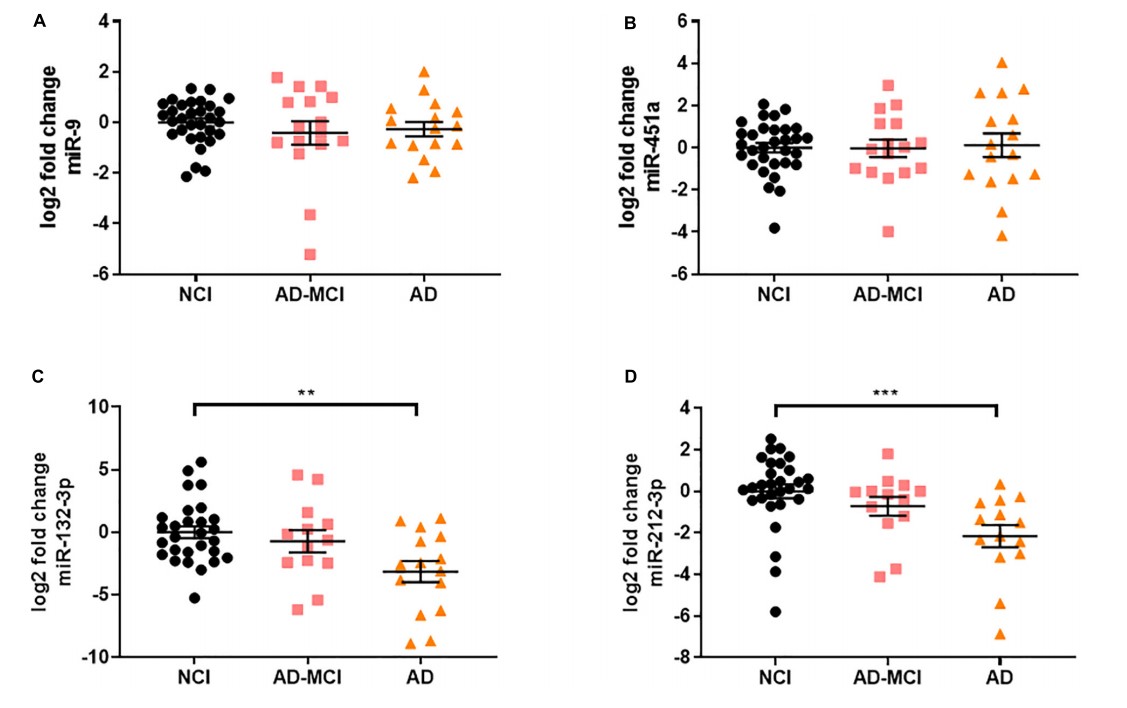 Figure 2. miR-132/212 expression significantly decreases in AD neural exosomes from plasma. (A) Neural-specific miR-9 was abundantly detected in all measured samples and was not significantly different between disease groups [X2(2) = 1.195, p = 0.550]. (B) Non-specific miR-451a were also detected in samples, but was unchanged between disease groups [F(2) = 0.035, p = 0.965]. Of the miRNAs significantly altered in AD brains, (C) miR-132 was significantly decreased in neural-derived plasma exosomes from AD subjects (∗∗ = 0.0333). (D) miR-212, a miRNA transcribed in tandem to miR-132, was also significantly decreased in AD ( ∗∗∗ = 0.001). Significance was determined by one-way ANOVA followed by Tukey's post hoc test for normally distributed data. Otherwise, Kruskal-Wallis test followed by Dunn's post hoc test was used. (Cha DJ, et al., 2019)
Figure 2. miR-132/212 expression significantly decreases in AD neural exosomes from plasma. (A) Neural-specific miR-9 was abundantly detected in all measured samples and was not significantly different between disease groups [X2(2) = 1.195, p = 0.550]. (B) Non-specific miR-451a were also detected in samples, but was unchanged between disease groups [F(2) = 0.035, p = 0.965]. Of the miRNAs significantly altered in AD brains, (C) miR-132 was significantly decreased in neural-derived plasma exosomes from AD subjects (∗∗ = 0.0333). (D) miR-212, a miRNA transcribed in tandem to miR-132, was also significantly decreased in AD ( ∗∗∗ = 0.001). Significance was determined by one-way ANOVA followed by Tukey's post hoc test for normally distributed data. Otherwise, Kruskal-Wallis test followed by Dunn's post hoc test was used. (Cha DJ, et al., 2019)
Case Study 2: Role of Plasma Exosomal LGALS3BP in Endometrial Cancer Progression and Prognosis
Endometrial cancer (EC) is the most common gynecological cancer and exosomes are involved in cell-to-cell communication: triggering proliferation, death, migration and angiogenesis. The hypothesis here is that plasma exosome composition changes with cancer progression and stimulates EC proliferation and angiogenesis by delivering biomolecules to cancer and vascular cells. Exosomes from EC patients increased cancer cell proliferation and angiogenesis in assays. This was followed by an increase in exosomal LGALS3BP (lectin galactoside-binding soluble 3-binding protein) as EC developed. LGALS3BP-overexpressing exosomes helped cancer cells grow and HUVECs function via the PI3K/AKT/VEGFA pathway. High levels of LGALS3BP in EC tissues were associated with poorer prognosis and higher VEGFA levels and vessel density. Taken together, these data suggest that LGALS3BP-containing plasma exosomes support EC progression and may aid in the diagnosis and prognosis of EC.
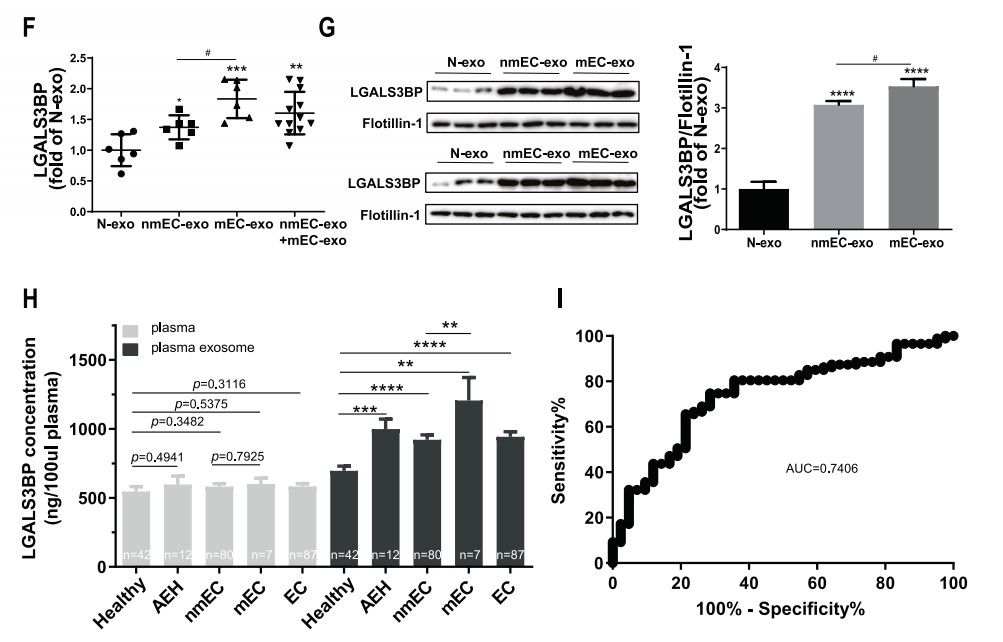 Figure 3. Analysis of TMT-labelled proteomics results and correlation of differentially expressed protein levels of LGALS3BP in plasma exosomes with EC progression. F LGALS3BP levels according to proteomic analysis (n = 6 for N-exo, nmEC-exo and mEC-exo; n = 12 for nmEC-exo+mEC-exo; *other groups vs. N-exo, *p < 0.05, ***p < 0.001; # mEC-exo vs. nmEC-exo, # p < 0.05; one-way ANOVA). G Western blot analysis showed LGALS3BP levels in plasma exosomes (n = 6 for N-exo, nmEC-exo and mEC-exo; n = 12 for nmECexo+mEC-exo; *other groups vs. N-exo, ****p < 0.0001; # mEC-exo vs. nmEC-exo, # p < 0.05; one-way ANOVA); flotillin-1, an exosomal protein marker, was used as a control. H ELISA results revealed LGALS3BP protein concentrations in plasma and plasma exosomes (**p < 0.01, ***p < 0.001, ****p < 0.0001; Kruskal–Wallis H test). I Receiver operating characteristic (ROC) curve analysis of the sensitivity, specificity and AUC (0.7406) of the plasma exosomal LGALS3BP level in EC patients (n = 42 for healthy donors, n = 87 for EC patients). All data shown in F and G–H are represented as the means ± SEMs. (Song, et al., 2021)
Figure 3. Analysis of TMT-labelled proteomics results and correlation of differentially expressed protein levels of LGALS3BP in plasma exosomes with EC progression. F LGALS3BP levels according to proteomic analysis (n = 6 for N-exo, nmEC-exo and mEC-exo; n = 12 for nmEC-exo+mEC-exo; *other groups vs. N-exo, *p < 0.05, ***p < 0.001; # mEC-exo vs. nmEC-exo, # p < 0.05; one-way ANOVA). G Western blot analysis showed LGALS3BP levels in plasma exosomes (n = 6 for N-exo, nmEC-exo and mEC-exo; n = 12 for nmECexo+mEC-exo; *other groups vs. N-exo, ****p < 0.0001; # mEC-exo vs. nmEC-exo, # p < 0.05; one-way ANOVA); flotillin-1, an exosomal protein marker, was used as a control. H ELISA results revealed LGALS3BP protein concentrations in plasma and plasma exosomes (**p < 0.01, ***p < 0.001, ****p < 0.0001; Kruskal–Wallis H test). I Receiver operating characteristic (ROC) curve analysis of the sensitivity, specificity and AUC (0.7406) of the plasma exosomal LGALS3BP level in EC patients (n = 42 for healthy donors, n = 87 for EC patients). All data shown in F and G–H are represented as the means ± SEMs. (Song, et al., 2021)
Product Advantages
- Relevance: Our exosomes are derived from authentic disease states, enabling studies that are both effective and highly relevant to human health. This translational advantage strengthens the bridge between bench research and clinical application.
- Quality Assurance: We have strict quality controls to ensure that our isolated exosomes are not contaminated or adulterated. This emphasis on quality ensures that your work is repeatable and reproducible, which is the most important aspect of any research project.
- Customization Options: We understand that no two research projects are the same. For all these different purposes, we offer customized exosome isolation solutions that allow researchers to choose specific techniques and protocols that suit their research. Because of this adaptability, our solutions are tailored to individual project goals for maximum impact.
Resources
Frequently Asked Questions
-
What disease state body fluids do you isolate your exosomes from?
We isolate our exosomes from a range of human disease state body fluids. See our full product catalog at the top of the page. We ethically treat and purify the fluids to obtain high purity exosomes that reflect the disease state. We also offer custom exosome isolation services in addition to the products listed above.
-
How are your exosomes quality controlled?
We have very strict quality control to ensure that our exosomes are pure and intact. We have the best labs and equipment for specialized exosome testing. One of the most complete systems with more than 60 confirmed exosome quality testing that are constantly updated.
-
How are your exosomes stored and handled?
Our exosomes are available as lyophilized powder or frozen liquid. The lyophilized powder is stable and can be stored for long periods at 4 °C; the frozen liquid is stored at -20 °C to -80 °C to maintain bioactivity. There are also handling and reconstitution guidelines to help you properly store and reconstitute exosomes.
Contact us to explore our range of exosomes isolated from human disease-state body fluids and discover how they can enhance your research efforts.
References
- Cha DJ, Mengel D, Mustapic M, et al. miR-212 and miR-132 are downregulated in neurally derived plasma exosomes of Alzheimer's patients. Front Neurosci. 2019;13:1208.
- Song Y, Wang M, Tong H, et al. Plasma exosomes from endometrial cancer patients contain LGALS3BP to promote endometrial cancer progression. Oncogene. 2021;40(3):633-646.
- Wang Z, Wang Q, Qin F, Chen J. Exosomes: a promising avenue for cancer diagnosis beyond treatment. Front Cell Dev Biol. 2024;12:1344705.
- Yu D, Li Y, Wang M, et al. Exosomes as a new frontier of cancer liquid biopsy. Molecular Cancer. 2022;21(1):56.
